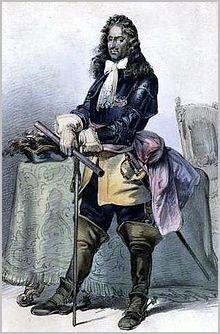

Ernst Rüdiger von Starhemberg, 1638-1701, military commander of Vienna was born in Graz. Left with less than 20,000 men against 300,000 besieging Turks he refused to capitulate, relying on the army of Leopold I, Holy Roman Emperor to relieve him and on the strength of the Vienna city walls, which were soon breached by the Turkish Sappers who had dug tunnels underneath the wall and detonated explosives. Vienna was soon teetering on collapse, but Von Starhemberg’s troops were well organized and disciplined. He organized companies of firefighters to defuse bombs and concentrated the city’s artillery at the point of Ottoman attack. However, the Ottoman siege cut virtually every means of food supply into Vienna, and the garrison and civilian volunteers suffered extreme misery and high casualties. Fatigue was such a problem that von Starhemberg ordered any soldier found asleep on watch to be shot.
On September 5th, rescue was close. Kara Mustapha expected to take Vienna in five hours, but made several tactical errors. He did not fortify his army or secure the hills of the Viennese woods. The main battle took place at “Kahlenberg” hill.
The siege itself began on July 14, 1683, with the Ottoman Empire army numbering approximately 150,000 men, including 12,000 Janissaries with an observation army of approximately 70,000 men watching the countryside. The decisive battle took place on September 11-12, after the united relief army of approximately 80,000 men had arrived.
On September 12, 1683, Christian forces included Duke Karl V von Lothringen with 8,000 men on foot, 12,000 men on horses and 70 cannons. The Saxons under the command of Duke Johann George III brought 7,000 men on foot, 2,000 on horses and 1,400 men with 16 cannons. The Bavarian Count Max Emanuel came with 7,500 men on foot, 3,000 on horses and 26 cannons. The Franken and Swabian troops under Count Georg Friedrich contributed 7,000 men on foot 2,500 on horses and 28 cannons. The total Christian forces had 75,000 troops and 150 to 170 cannons. The Turks had 30,000 men in the trenches around Vienna and 107,000 troops and 300 cannons to oppose the Christian armies. Lastly, King Jan Sobieski III of Poland arrived with a force of 10,200 men on foot, 14,000 on horses and 28 cannons.
At four o’clock in the morning the Imperial soldiers were praying in a ceremony in open field. They had been fighting for hours with grave losses while the Polish King waited on high ground watching, the Germans having failed to persuade him to move forward and intervene earlier. Finally, the army was divided into three groups: Imperials and Saxons on the left wing, Bavarians center, and the Polish taking the right. Ibrahim, the Pascha of Ofen, broke forth upon the Poles and several troops ran away. Count Ludwig of Baden then attacked with two of his Imperial dragoon regiments, and succeeded in rolling back the Turkish line thanks in part to brilliant Prinz Eugen von Savoyen.
Duke Charles of Lorraine gained the victory by undertaking a daring wheeling movement with doubling and flanking movements. They totally destroyed the Turkish Army and the road to Vienna was now opened. Rüdiger von Starhemberg had heroically defended the city of Vienna with 10,000 men. The Turks lost at least 15,000 men with at least 5,000 men captured and all cannons, while the Habsburg-Polish forces lost approximately 4,500 dead and wounded. Kara Mustafa was executed in Belgrade later that year by order of the commander of the Janissaries. From this point on, European confidence grew and the battlefield success of the Turks waned. After winning the Battle of Vienna, the Europeans gained advantage and led the reconquest of Hungary which ended with the Treaty of Karlowitz in 1699. Within the Ottomans, infighting developed, however, they still had immense power as they had gained great wealth by their control over shipping and trade routes.
Poland, Saxony, Bavaria, Baden, Franconia and Swabia all answered the call for a Holy League supported by Pope Innocent XI to save western civilization. Only Habsburg rival Louis XIV of France declined to help, thus weakening the Emperor’s forces in the east. Instead, he used the opportunity to ruthlessly and greedily annex territories in western Europe such as Luxembourg and Alsace with Strasbourg, just as France had done in the Thirty Years’ War. Had the Ottomans won, France would have immediately been the strongest nation in Europe. Because of the ongoing war against the Turks, Austria could not lend support to her German allies in the West, and France pounced at the opportunity.
It was not until later, when the combined Austrian and German forces of the “Empire of German Nations” under the leaders Karl V von Lothringen, Max Emanuel von Bayern and Ludwig Wilhelm I von Baden defeated the Turks at Harsany (Harschan) near Mohács in 1686-1687 that the Islamic threat to the Christian Civilization finally came to a halt. Once again, France took advantage of the situation to further raid, burn and plunder Germany. The repulsion of the Turks constituted the climax of the Turkish Wars and to most Europeans, the salvation of Christianity. To commemorate, church bells rang daily at noon and six throughout parts of Europe for many decades.